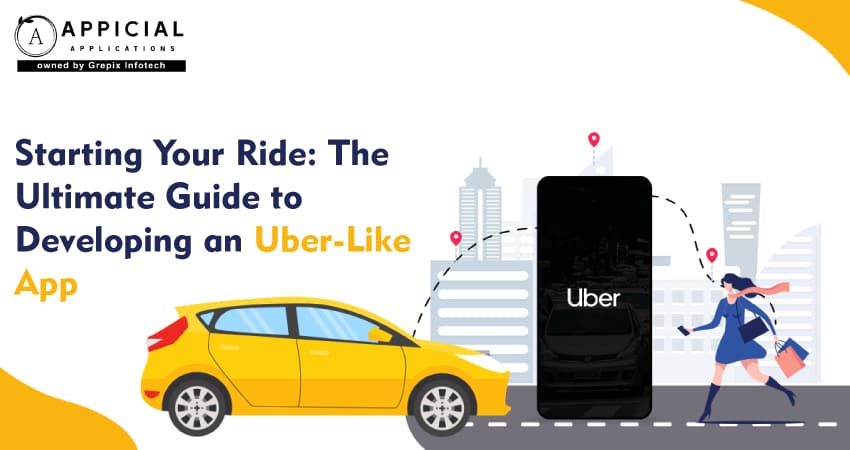
Starting Your Ride: The Ultimate Guide to Developing an Uber-Like App
In today's fast-paced world, mobile apps that simplify our everyday activities are not just conveniences—they are necessities. Among these, ride-sharing apps have dramatically transformed how we commute, bringing unparalleled ease to our travels and shaking up traditional transport systems. Uber, the pioneer in this sector, has inspired countless entrepreneurs to explore this lucrative market. If you're looking to launch a similar venture, "Starting Your Ride: The Ultimate Guide to Developing an Uber-Like App" is your essential roadmap.
This guide will walk you through every step of the journey—from conceptualization and market analysis to development and deployment—ensuring you're well-equipped to create a ride-sharing app that is not only functional but also competitive in the evolving digital landscape. Whether you aim to compete with giants like Uber and Lyft or to carve out a niche in local markets, this guide offers the insights and strategies needed to kickstart your entrepreneurial journey in the world of ride-sharing.
Starting Your Ride: The Ultimate Guide to Developing an Uber-Like App" provides an all-encompassing overview of creating a ride-sharing app. It begins with ideation and detailed market research to understand target users and competitors. The blog outlines key business models like commission, subscription, and freemium, and emphasizes the importance of a suitable technology stack and compelling UX design. Critical features like geolocation, booking interfaces, and payment systems are discussed. The guide also covers legal compliance, agile development, and strategic marketing. Continuous improvement post-launch ensures the app remains competitive. This guide serves as a roadmap for entrepreneurs eager to enter the ride-sharing market.
Understanding the Market
Before you dive into the development process, it's crucial to understand the ride-sharing market. This sector is highly competitive and regulated differently across regions. Conduct thorough market research to identify your target audience, understand their needs, and analyze your competitors. This will help you find a niche or an innovative approach that can set your app apart from existing offerings.
Defining Your Business Model
The business model you choose is pivotal to the success of your ride-sharing app. It determines how you generate revenue, engage with drivers, and position yourself in the market. Most ride-sharing apps, like Uber and Lyft, utilize a commission-based model, but there are other models to consider based on your strategic goals and the specific needs of your target market. Let’s explore some viable business models for your ride-sharing app:
Commission Model
Under the commission model, the app owner earns a percentage of the fare for each ride completed through the platform. This model is straightforward and aligns the interests of the app owner with those of the drivers: the more the drivers earn, the more the platform earns. The commission rates can vary, typically ranging from 15% to 30%. This model is popular due to its simplicity and direct correlation to app usage and popularity.
Subscription Model
In the subscription model, drivers pay a fixed fee to be listed on your app, regardless of how much they actually earn. This model can be attractive to drivers who prefer predictable costs and can be particularly effective in regions with high demand consistency. It assures the app owner of a steady income stream, but it may require differentiating features or lower fees compared to competitors to attract and retain drivers.
Freemium Model
The freemium model offers basic app functionalities for free while charging for premium features. These features could include the ability to receive rides from more lucrative locations, higher visibility in the app, or access to more favorable ride requests. This model can attract a large base of drivers who might later opt for premium features as they see the potential value in the additional cost. It also allows new drivers to try the platform with no initial investment, reducing barriers to entry.
Also Read: Mobile App Development: A Step-by-Step Guide for 2024
Key Features of a Ride-Sharing App
Your app needs to be user-friendly, efficient, and packed with essential features that appeal to both drivers and passengers. Here are some key features to consider:
- User Registration and Profiles: Easy registration process for both drivers and passengers, with profiles that can store history and preferences.
- Geolocation and Routing: Integration of GPS technology to facilitate route planning and finding the nearest available ride.
- Booking Interface: An intuitive interface for booking rides, with options to choose different types of vehicles.
- Fare Calculator: A feature to calculate the fare based on distance, type of car, and local rates.
- Payment Integration: Secure and versatile payment options including credit/debit cards, mobile wallets, and perhaps even cryptocurrency.
- Driver and Passenger Rating System: A transparent system for feedback on both drivers and passengers to ensure safety and trust.
- Push Notifications: Real-time updates about trip status, changes, and promotions.
Technology Stack
Choosing the right technology stack is crucial for building a robust and scalable app. Here are some technologies commonly used in the development of ride-sharing apps:
- Frontend: Technologies like React Native or Flutter for a seamless, cross-platform mobile experience.
- Backend: Node.js or Python (Django) to handle server-side operations.
- Database: MongoDB or PostgreSQL to manage user data, driver data, transactions, etc.
- GPS Tracking: Google Maps API for location tracking and routing.
- Payment Gateway: Stripe, PayPal, or Braintree for processing payments securely.
How to create an App Like Uber
Developing an Uber-like app involves several key steps, each critical to ensuring the app's functionality, user engagement, and market viability. Here’s a detailed breakdown of the development process:
Ideation and Market Research
The initial phase in developing an Uber-like app involves ideation and comprehensive market research. This stage is crucial as it sets the foundation for your app's development. During ideation, you crystallize your app's concept, focusing on identifying unique features that can distinguish your service in a competitive marketplace. Market research then plays a vital role, as it involves gathering insights about potential users, analyzing competitors.
Planning and Strategy
The planning and strategy phase of developing an Uber-like app is critical in transforming your initial ideas into a viable product roadmap. This stage requires meticulous organization and forward-thinking to lay down a concrete plan that will guide the entire development process.
Design and User Experience
The design and user experience (UX) of your app can be a make-or-break factor in its success. The interface should be clean, attractive, and easy to navigate. Invest in good UX design to ensure that both drivers and passengers find the app practical and pleasant to use. Consider working with experienced designers who understand the nuances of mobile app design.
Regulatory Compliance
Understanding and complying with local laws and regulations related to transportation services is critical. These regulations can vary significantly from one region to another and can affect how you structure your business, manage driver registrations, and handle insurance and liabilities.
Developing and Testing
Development should follow best practices in agile methodologies, allowing for iterative testing and improvements based on feedback. Thorough testing is essential to ensure the reliability and safety of your app. This includes functional testing, user experience testing, performance testing, and security audits.
Launch and Marketing
A strategic launch and marketing plan is essential to get your app off the ground. Start by launching in a smaller area to iron out any issues before going wider. Use digital marketing strategies like SEO, social media marketing, influencer partnerships, and targeted ads to reach your audience. Offering launch promotions and incentives can also help attract initial users to your platform.
Continuous Improvement
After launch, your job isn't over. The most successful apps are continually improved based on user feedback and evolving market conditions. Keep an eye on how users are interacting with your app and what pain points they have. Regular updates and new features will keep your app competitive and relevant.
Conclusion
Embarking on the journey to develop an Uber-like app can seem daunting, yet it is undeniably rewarding for those who navigate it with precision and strategic foresight. As we've explored in "Starting Your Ride: This guide has covered everything from the initial market research and ideation to the detailed planning and strategy phases, ensuring you are well-equipped to embark on this exciting journey.
Developing an app akin to Uber is no small feat—it requires precision, innovation, and a deep understanding of the market's needs. Our expertise and experience in developing customized ride-sharing solutions can help you navigate this complex landscape. We understand the nuances of app development, the importance of an intuitive user experience, and the critical nature of strategic feature selection. Our commitment to using the latest technology ensures scalability and robustness in all our projects.
Whether you're looking to launch a local ride-sharing service or aim to compete on a global scale, we are here to support you every step of the way. From conceptualization to launch and beyond, Appicial Applications is your trusted partner, turning your visionary ideas into reality. Let's drive forward together, transforming the way the world moves, one ride at a time.
Launch your vision with our mobile app development company, where innovation meets excellence to create cutting-edge mobile solutions.







